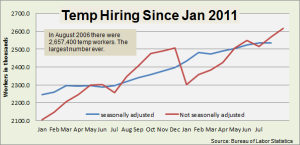 The U.S. economy added 114,000 new jobs in September, as the unemployment rate dropped to its lowest level since January 2009. It’s now at 7.8%, down from last month’s 8.1%.
The U.S. economy added 114,000 new jobs in September, as the unemployment rate dropped to its lowest level since January 2009. It’s now at 7.8%, down from last month’s 8.1%.
The staffing industry, one of the economy’s strongest jobs growth sectors, declined in September on a seasonally adjusted basis, trimming 2,000 positions. The broader employment services sector, which includes search firms, registries, employment agencies and other similar businesses, was down another 3,400 jobs.
Both counts, however, are well above where they were a year ago. The temp industry is up 192,400 jobs over September 2011, driving the broader employment services sector up by 220,200 jobs.
On a non-seasonally adjusted basis, the temp sector added 47,100 jobs in September, following August’s 54,800 increase.
September’s jobs report, released this morning by the Bureau of Labor Statistics, also improved the initial July and August estimates for the temp sector, as well as for the overall, national economy. The adjustments, which are routinely made every month when the employment report is released, added 86,000 non-farm jobs to July and August.
Temp jobs, which were initially reported down in August by 4,900, now show an increase of 2,100 for the month. July’s temp job increase went from 6,700 to 11,000.
Yesterday, CareerBuilder released a survey predicting continued increases for the rest of this year in both contract labor and permanent full-time positions.
Even with the slight decline in September’s staffing jobs, the sector is nearing its all time job count of 2.657 million (seasonally adjusted) reached in August 2006. The BLS says that as of the September report, there were 2.534 million temp jobs.
Part-time hiring by direct employers helped lower the unemployment rate during the month. The BLS said 873,000 workers got jobs during September, the first significant increase in three months. The increase, however, pushed the number of people working part-time because they can’t find full-time work up by almost 600,000 in September to 8.6 million.
But with the number of workers participating in the labor force unchanged during the month, the decline in the unemployment rate was due to more people working, rather than a smaller overall workforce.
Because different surveys are used by the Bureau of Labor Statistics to calculate employment and job growth, the two numbers, though related, don’t correlate directly in any one month.
The number of unemployed Americans declined by 456,000 to 12.1 million. A year ago it was 13.9 million. Another 2.5 million are out of work, but not officially counted as unemployed. When these numbers are considered, along with the part-timers who want full-time work, the unemployment/underemployment rate is at 14.7 percent.
 Private sector employers, meanwhile, reported creating 104,000 non-farm jobs on a seasonally adjusted basis last month; state governments added 10,000, one of the few times in the last several years there was an increase in government hiring. (There was an increase of 45,000 government jobs in August.) Most of the new jobs came in education. Economists expected the private sector to add about 130,000 jobs. ADP reported Wednesday that its count of private, non-farm jobs showed a September increase of 162,000.
Private sector employers, meanwhile, reported creating 104,000 non-farm jobs on a seasonally adjusted basis last month; state governments added 10,000, one of the few times in the last several years there was an increase in government hiring. (There was an increase of 45,000 government jobs in August.) Most of the new jobs came in education. Economists expected the private sector to add about 130,000 jobs. ADP reported Wednesday that its count of private, non-farm jobs showed a September increase of 162,000.
All the job gains came in the service sector, which added 114,000 jobs overall. Manufacturing, which had been adding jobs, took a big hit during the month, declining by 16,000. About a third of the loss came from cuts in computer and electronic products manufacturing. Construction added 5,000 positions.
The big gainers were healthcare, which added 44,500 jobs, with 29,500 of them coming from increases in doctor’s offices, outpatient care centers, and home health care. Food services and bars also added big, growing by 15,700 jobs.
Transportation and warehousing jobs increased by 17,100, as transit and group passenger services added 9,200 jobs and warehousing and storage added 4,300.
The financial sector also was hiring, increasing its overall workforce by 13,000 workers, with more than half the jobs — 8,100 — coming in the real estate.
Average earnings rose by seven cents to $23.58 an hour, while the average workweek edged up by 0.1 hour to 34.5 hours in September.
To the north, Canadian employment numbers, also released this morning, took a big jump adding 52,000 workers to the economy there. The increase was five times what economists had forecast, Bloomberg reported.